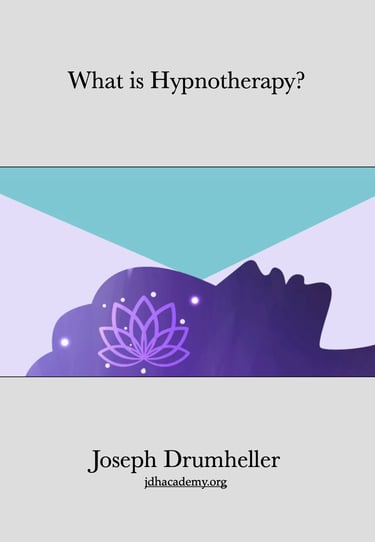Add your promotional text...
What Happens in a Clinical Hypnotherapy Session?
A brief description about what to expect in your first session
HYPNOTHERAPY
Joseph
8/20/20255 min read


Have you ever wondered what actually happens in a hypnotherapy session? Is it some kind of mind control? Do you lose your personal power?
These are great questions and common misconceptions about hypnotherapy. Here what you'll really be getting into.
Pre-Session Interview: Assessing Client Needs
The pre-session interview is a critical initial step in the hypnotherapy process. It serves as a foundation for building a productive relationship between the therapist and the client, enabling the therapist to gather essential information about the client’s background, current challenges, and motivations for seeking hypnotherapy. During this phase, the therapist engages the client in a comfortable dialogue, delving into relevant details that may impact the treatment approach.
Understanding the client's history is vital. The therapist typically inquires about previous experiences with therapy, medical history, and any mental health considerations that may influence the hypnotherapy process. Furthermore, knowing a client’s past allows the therapist to identify patterns that may need to be addressed during the sessions. In addition to clinical information, the interview aims to uncover the client’s specific issues and concerns—whether they range from anxiety, stress management, habit modification, or trauma healing. This level of clarity can significantly enhance the efficacy of the hypnotherapy sessions.
Equally essential is the establishment of trust and rapport. The pre-session interview encourages an open dialogue, promoting a safe environment where the client feels heard and validated. The therapeutic relationship is crucial in hypnotherapy, as effective treatment often hinges on the client's ability to relax and cooperate with the process. By investing time in the pre-session interview, the therapist demonstrates commitment to understanding the client's unique needs, thus tailoring approaches to ensure the hypnotherapy experience is both personalized and effective.
Induction into Deep Relaxation
During a hypnotherapy session, the process of induction into deep relaxation is crucial as it sets the foundation for effective therapeutic intervention. This initial phase involves the therapist guiding the client through a series of techniques designed to promote a state of focused calmness. One common method utilized is breath control, where clients are instructed to take slow, deliberate breaths. This practice not only enhances physical relaxation but also serves to center the mind, facilitating a transition away from everyday distractions. To get a taste of it, a free online video for progressive relaxation is a great place to start
In tandem with breath control, visual imagery plays a significant role in the induction process. Clients may be asked to visualize serene landscapes or calming environments, allowing their minds to conjure images that evoke a sense of peace. By engaging the imagination, the therapist helps the individual to further disconnect from external stimuli and tap into their inner consciousness. This state of heightened focus and receptiveness is essential for the success of hypnotherapy as it prepares the client for deeper exploration of their thoughts and emotions.
The significance of achieving a profound state of relaxation cannot be overstated. A relaxed mind is more open to suggestion, which is a cornerstone of hypnotherapy's effectiveness. The induction phase is not merely a preliminary step; it is a vital part of the overall therapeutic process. By employing techniques such as breath control and visual imagery, therapists can cultivate a conducive environment for change, allowing clients to access their subconscious mind and engage with the issues they wish to address.
Ultimately, mastering the induction into deep relaxation leads to more successful hypnotherapy sessions, paving the way for profound personal insights and transformative experiences.
Administering Techniques
In a hypnotherapy session, various techniques are employed to address a client's specific needs, ensuring a tailored approach to their unique goals. One of the primary methods is suggestion therapy. This technique involves the therapist providing positive suggestions while the client is in a relaxed, trance-like state. Suggestions are crafted thoughtfully, often focusing on behavioral changes, emotional healing, or promoting physical well-being. Effective suggestion therapy helps clients reframe negative thought patterns, thereby nurturing a more positive outlook on their circumstances.
Another core technique utilized is regression therapy, which allows clients to revisit past experiences that may be influencing their present behaviors or emotional states. Through guided visualization, the therapist facilitates the client in accessing their subconscious mind, where they can explore these past events safely. This exploration can lead to valuable insights, fostering healing by enabling individuals to process unresolved issues from their past experiences.
Additionally, visualizations are frequently incorporated into hypnotherapy sessions. This technique guides clients to imagine specific scenarios or environments that evoke a sense of calmness and safety. By visualizing positive outcomes or relaxation, clients can reinforce their ability to cope with stress or anxiety effectively. The process is integral to forging a deeper connection between the mind and body, enhancing overall therapeutic efficacy.
The therapist's role in this phase is crucial; they act as a facilitator, ensuring that clients feel secure and supported throughout the session. By employing active listening and empathy, therapists create a nurturing environment conducive to healing. Clients typically experience a blend of deep relaxation and heightened awareness during these techniques, which ultimately empowers them to embrace positive change and achieve their objectives. Understanding these methods reveals the intricacies of hypnotherapy and highlights its potential in fostering personal growth.
Safe and Gentle Ending, Follow-Up
Concluding a hypnotherapy session safely and gently is a crucial aspect of the overall therapeutic process. As the session comes to an end, the therapist will gradually guide the client back from the hypnotic state to full awareness. This transition is performed with care, utilizing calming and reassuring language to help the client feel at ease. The process often involves counting up from a specific number or using gentle suggestions, allowing the client to slowly return to their normal state of consciousness. This careful reorientation helps prevent any disorientation or discomfort that may occur if the transition is abrupt.
After the session has concluded, it is essential for therapists to provide follow-up communication, typically occurring a few days later. This follow-up serves several purposes, including assessing the client's progress, understanding their experiences, and gathering feedback. During this follow-up, a therapist may inquire about any changes the client has noticed since the session, such as improved coping mechanisms or shifts in mindset. Addressing these updates facilitates a deeper understanding of the efficacy of the hypnotherapy provided, helping both the therapist and client evaluate the results.
Furthermore, the follow-up serves as an opportunity for clients to ask questions or raise any concerns regarding their experiences. It fosters a supportive environment that encourages engagement and transparency. If a client feels uncertain about a particular sensation or experience they encountered during hypnosis, the follow-up discussion allows for clarification and comfort. Overall, concluding the hypnotherapy session safely and implementing a thoughtful follow-up procedure contribute significantly to the success of the therapeutic journey, ensuring that clients feel supported and informed every step of the way.
To learn more about the fascinating world of Hypnotherapy, get you free pdf file, What is Hypnotherapy? Now is the time to take action and discover the magic of your subconscious mind!





